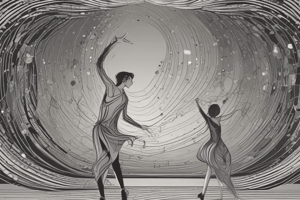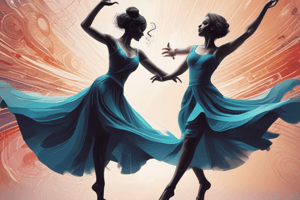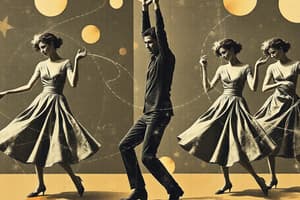Podcast
Questions and Answers
What term refers to a printed symbol of a musical tone?
What term refers to a printed symbol of a musical tone?
- Phrase
- Note (correct)
- Count
- Measure
What is the term for measures grouped together in music?
What is the term for measures grouped together in music?
- Meter
- Count
- Phrase (correct)
- Bar
Which type of movements involves the feet moving in space?
Which type of movements involves the feet moving in space?
- Non-locomotor movements
- Static movements
- Locomotor movements (correct)
- Rotational movements
What describes the path or design made while moving in space?
What describes the path or design made while moving in space?
Which of the following is an example of a non-locomotor movement?
Which of the following is an example of a non-locomotor movement?
What element refers to the line of movement taken in space?
What element refers to the line of movement taken in space?
Which of these is considered a fast movement?
Which of these is considered a fast movement?
What term describes movements that are done at a high, low, or medium level?
What term describes movements that are done at a high, low, or medium level?
Which of the following is a type of creative dance?
Which of the following is a type of creative dance?
What is the formation commonly referred to as 'double lines' used for?
What is the formation commonly referred to as 'double lines' used for?
Which value of dancing emphasizes social interaction?
Which value of dancing emphasizes social interaction?
In the 1st position, how should the feet be positioned?
In the 1st position, how should the feet be positioned?
What is the arm position in the 3rd position?
What is the arm position in the 3rd position?
Which of the following is NOT a fundamental position in dance?
Which of the following is NOT a fundamental position in dance?
What is the distance between feet in the 2nd position?
What is the distance between feet in the 2nd position?
In which formation do partners face each other?
In which formation do partners face each other?
What is the definition of rhythm?
What is the definition of rhythm?
Which of the following does NOT describe rhythmic activities?
Which of the following does NOT describe rhythmic activities?
What is the main objective of rhythmic activities?
What is the main objective of rhythmic activities?
Which element of rhythm refers to the underlying pulse?
Which element of rhythm refers to the underlying pulse?
How is dance defined in the context of rhythmic activities?
How is dance defined in the context of rhythmic activities?
Which element of rhythm describes the rate of speed of a movement?
Which element of rhythm describes the rate of speed of a movement?
What does the term 'accent' refer to in rhythmic activities?
What does the term 'accent' refer to in rhythmic activities?
Which of the following is NOT a fundamental rhythmic skill?
Which of the following is NOT a fundamental rhythmic skill?
What is an example of smooth, sustained movement?
What is an example of smooth, sustained movement?
Which dance form is characterized by its cultural significance and is passed down through generations?
Which dance form is characterized by its cultural significance and is passed down through generations?
What type of movement does a yo-yo primarily demonstrate?
What type of movement does a yo-yo primarily demonstrate?
Which of the following is a characteristic of social and ballroom dance?
Which of the following is a characteristic of social and ballroom dance?
What is the main goal of creative dance?
What is the main goal of creative dance?
Which type of dance includes dance mixers and square dances?
Which type of dance includes dance mixers and square dances?
What type of movement is exemplified by a merry-go-round?
What type of movement is exemplified by a merry-go-round?
Which dance form involves a more formal setting with participants usually in formal attire?
Which dance form involves a more formal setting with participants usually in formal attire?
Flashcards are hidden until you start studying
Study Notes
Understanding Rhythm and Dance
- Every individual has an innate sense of rhythm, present in nature and exemplified through dance.
- Rhythm is characterized by the regular recurrence of accented and unaccented beats; it manifests as rhythmic movements in response to music.
- Rhythmic activities reflect mental and emotional responses, fostering physical, social, and mental engagement.
Objectives of Rhythmic Activities
- Develop recreational enjoyment skills.
- Maintain good posture and physical efficiency.
- Promote emotional freedom and expression.
- Cultivate a balanced and well-coordinated physique.
Elements of Rhythm
- Beat: The foundational pulse of rhythm.
- Tempo: The speed at which movements occur.
- Intensity: Variations in the pressure applied during movement.
- Pitch: The highness or lowness of sound.
- Accent: Emphasis placed on specific beats.
- Meter: The recurring pattern of beats within measures.
- Phrase: Grouping of measures into recognizable segments.
- Measure: Defined as a group of pulse beats separated by bar lines.
Elements of Movement Space
- Direction: Movement can be forward, backward, sideways, diagonal, or upward.
- Level: Movements can occur at high, medium, or low levels.
- Range: Can vary from small (localized) to large (wide coverage).
- Floor Pattern: The trajectory of movement can form various shapes, like circles or straight lines.
Movement Qualities
- Time: Movement can be fast or slow; examples include a galloping horse versus a growing flower.
- Natural Movements:
- Locomotor: Movements that propel the body through space (e.g., walking, running).
- Non-locomotor: Body parts move with a fixed base (e.g., bending, twisting).
Phases of Dance Programs
- Creative Rhythms: Spontaneous movements from exploration, emphasizing expression.
- Folk/Ethnic Dance: Cultural dances portraying traditions and community life.
- Social and Ballroom Dance: Formal dances often held at social gatherings, emphasizing etiquette.
- Recreational Dance: Informal settings with simple dance patterns.
- Creative Dance: High form of dance, often choreographed with emotional expression.
Common Dance Formations
- Single circles, double circles, squares, semi-circles, and lines are prevalent layouts for rhythmic activities.
Values of Dancing
- Contributes to physical fitness, cultural appreciation, social interaction, and recreational enjoyment.
Fundamental Dance Positions
- There are five basic positions of feet and arms:
- 1st Position: Heels together, toes angled; arms form a circle at chest level.
- 2nd Position: Feet apart with arms raised sideward.
- 3rd Position: One foot close to the other; one arm at chest level, the other raised.
- 4th Position: One foot ahead of the other; arms raised in front and overhead.
- 5th Position: Front foot's heel near the rear foot's big toe; both arms overhead.
Studying That Suits You
Use AI to generate personalized quizzes and flashcards to suit your learning preferences.




